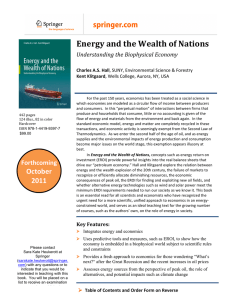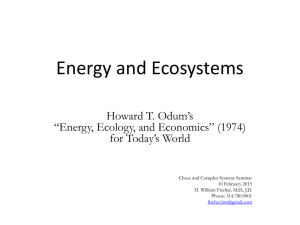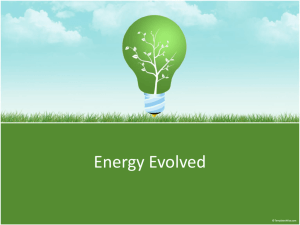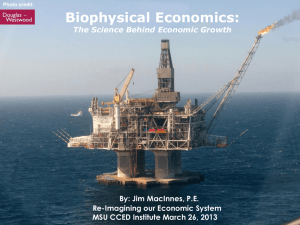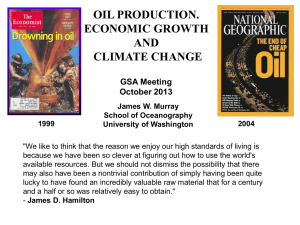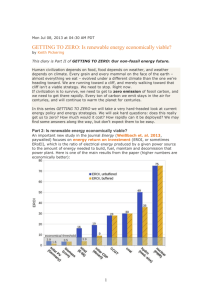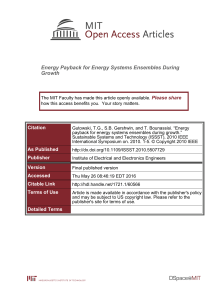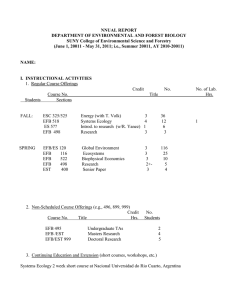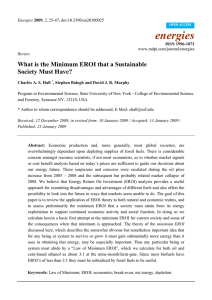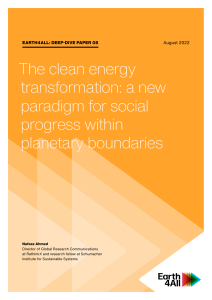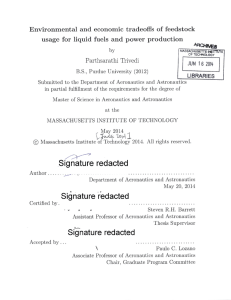EROI, Insidious Feedbacks, and the End of Economic Growth David J. Murphy
advertisement
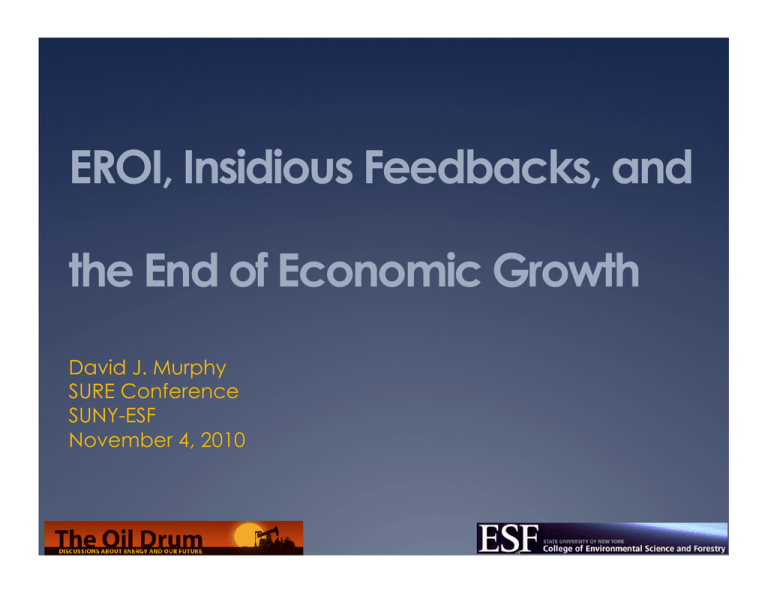
EROI, Insidious Feedbacks, and the End of Economic Growth David J. Murphy SURE Conference SUNY-ESF November 4, 2010 1. Economic Production Correlates with Energy Production 2. When oil consumption grows, so does the U.S. economy 3415+61$7/7$89+,61$.,$:.;$8/,-<=*>/,$ "#$ US Oil consumption from 1970 - 2008 %#$ &#$ '#$ ()*+,-./,$ !&#$ !%#$ !"#$ 0121--./,$ 3. 50% of the variation in GDP is explained simply by oil consumption Is oil the chicken or the egg? Karanfil 2009 Is oil the chicken or the egg? 4. Adjusting energy for quality differences among fuel types indicates causality running from energy consumption to GDP Cleveland et al. (2000) But its not just energy that grows the economy It is CHEAP energy 5. Oil Prices are Lower During Expansions )!" Average Real Oil price from 1970 - 2008 5637-83"23-9":09";7043" (!" '!" &!" %!" $!" #!" !" *+,-./01." 2343//01." 6. Every recession since 1970 has been preceded by a spike in the price of oil 7. Supply Curve '#!" Decrease of ~2 mbpd lowers price to $30 bbl ,-."/0-12"34566.7" '!!" &!" %!" $!" #!" !" !" '!" #!" (!" $!" )!" ,-."89::.;"3<6:=7" %!" *!" &!" +!" 8. Supply didn’t increase with Price 9. We are finding less oil 10. The oil we do find is in hard to reach places (i.e. expensive) Summary of the Facts Inexpensive energy has been used to provide steady economic growth in the recent past We are finding less oil, and the oil we do find is expensive, creating a volatile price situation Peak-Era Growth Model This system of insidious feedbacks is aptly described as a growth paradox: maintaining business as usual economic growth will require the production of new sources of oil, yet the only sources of oil remaining require high oil prices, thus hampering economic growth. Peak-Era Growth Model GDP Time What is so different between this recession and past recessions? Peak Oil EROI Are oil supplies constrained? Are oil supplies constrained? OPEC Spare Capacity estimates from McKinsey and Co. When was/will be the peak? Does the date actually matter? The peak may have occurred in 2005 for conventional crude and 2008 for liquids But it does not matter What does matter: Will the supply of oil be constrained in the future? Energy Return on Investment (EROI) EROI = Energy Out / Energy In Energy Out (MJ) OIL Cement Steel Other Inputs Energy In (MJ) Price and EROI ,-./01-2"3.4567841"94:;:"4."<=-2">02"3.07=" ?941:;-1;"$!!)"@ABB2C" +!" Oil Sands *!" )!" Average price during recessions (!" Ultra-Deep '!" Global Average &!" Average price during expansions %!" $!" Saudi Crude #!" !" &'" Extraction Difficulty, Time &!" %'" %!" $'" $!" D<>E" #'" #!" '" !" What does all this mean for economic growth? For the first time in the past 140 years we will try to grow the economy on a declining oil supply What about alternatives? “As resources become scarce and relative costs change, substitutions will occur to ameliorate effects of diminishing returns” Barnett and Morse, Scarcity and Growth (1963) “Resource scarcity has been successfully handled with the help of technical progress that has widened the resource base and/or by substitution. The 20th century has been referred to as ‘the age of substitutibility.’ The 21st century will be even more so.” Radetzki (2010) Substitution takes a long time How does EROI impact society? Energy flow to society Oil Economy Biofuel Economy How does economic growth (or a lack thereof) impact alternative energy sectors? Financing alternative energy projects will become increasingly difficult (ceteris paribus) Volatile fossil fuel prices – boom and bust cycles Large upfront investments require deep pockets Largest unknown – policy subsidizing renewables or taxing oil and gas sectors Natural gas in particular is troubling for renewable energy, as it is both feedstock and competitor for various alternatives “VeraSun Energy Co.'s decision to delay the openings of two of the largest U.S. ethanol plants reflects the immense pressure ethanol producers are under as their margins are squeezed by high corn and natural gas prices.” http://www.marketwatch.com/story/ethanol-plant-closings-may-come-as-margins-vanish “American Electric Power CEO Michael Morris took this sentiment a step further, claiming that shale gas at $5.00 MMBtu (~3.5cents/ kWh) represents a challenge for the U.S. renewable energy sector.” http://www.greentechmedia.com/articles/read/will-natural-gas-hurt-renewables/ Demand: An Ace in the Hole! A systematic decrease in oil demand may have unknown, and hopefully positive, impacts on the economy The average European consumes half the energy of the average American Half of our oil consumption ~ 9 mbpd Thank You Very Much! Contact information: djmurphy04@gmail.com, 315-412-4619 References: 1. Cleveland, Kaufmann and Stern. 2000. Aggregation and the role of energy in the economy. Ecological Economics, 32: 2. Hubbert. 1956 of Conference. Nuclear Energy and the Fossil Fuels. Spring Meeting of the Southern District Division of Production, San Antonio, Texas. 3. CERA. 2006. United States Production, Hubbert Vs. Actual. Cambridge Energy Research Associates. 4. Ericksen. 2009. Global Oil Production. The Oil Drum. 5. Gagnon, Hall and Brinker. 2009. A Preliminary Investigation of the Energy Return on Energy Invested for Global Oil and Gas Extraction. Energies, 2 490 – 503. 6. Hall, Powers and Schoenberg. 2008. Peak Oil, EROI, Investments and the Economy in an Uncertain Future. In Biofuels, Solar and Wind as Renewable Energy Systems: Benefits and Risks. Pimentel Ed^. Springer Netherlands. Netherlands. 7. Kahneman and Deaton. 2010. High income provoes evaluation of life but not emotional wellbeing. Proceedings of the National Academcy of Sciences, 8. Radetzki, M. 2010. Peak Oil and Other Threatening Peaks – Chimeras Without Substance. Energy Policy, 38, pp. 6566 – 6569.
